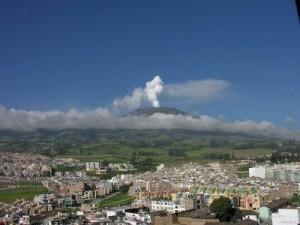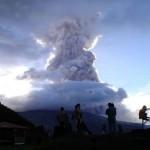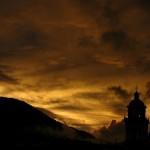

Galeras eruption image – courtesy and copyright Josecamilom
Galeras, a stratovolcano with a large breached caldera located immediately west of the city of Pasto (a city with approx. 400,000 inhabitants), is one of Colombia’s most frequently active volcanoes.
The dominantly andesitic Galeras volcanic complex has been active for more than 1 million years, and two major caldera collapse eruptions took place during the late Pleistocene. Long-term extensive hydrothermal alteration has affected the volcano. This has contributed to large-scale edifice collapse that has occurred on at least three occasions, producing debris avalanches that swept to the west and left a large horseshoe-shaped caldera inside which the modern cone has been constructed.
Major explosive eruptions since the mid Holocene have produced widespread tephra deposits and pyroclastic flows that swept all but the southern flanks. A central cone slightly lower than the caldera rim has been the site of numerous small-to-moderate historical eruptions since the time of the Spanish conquistadors.
Eruptions
Galeras is considered the most active volcano in Colombia, followed by Nevado del Ruiz. Its earliest activity during the Holocene has been dated at 7050 BC ± 1000 years through radiocarbon dating. Other eruptions similar to this event include those in 3150 BC ± 200 years, 2580 BC ± 500 years, 1160 BC ± 300 years, 490 BC ± 100 years, and in 890 AD ± 200 years. Typically these eruptions consist of a central vent explosion, conducive to an explosive eruption causing pyroclastic flows and/or lahars. Eruptions in more recent times, which have been recorded consist of those in 1535, December 1580, July 1616, 1641, 1670, 1754, November 1796, June 1823, October 1828, 1834, October 1865, July 1889, 1891, December 1923, October 1924, October 1932, February 1936, July 1947, January 1950, 1974, February 1989, January 1990, January 1993, March 2000, June 2002, July 2004, November 2005, and October 2007. Reported incidents with no official proof occurred in 1836, 1930, 1933, and 1973.
Galeras became active again in 1988 after 10 years of dormancy. A Decade Volcano conference in the city of Pasto, in 1993, ended in disaster when several of the scientists present mounted an impromptu expedition on 14 January to the crater of Galeras. An eruption occurred unexpectedly while they were at the summit, which resulted in the deaths of six scientists and three tourists. Elements in the media made the event controversial by suggesting the team leader Stanley Williams, who survived, had ignored safety procedures. A prediction had been made three days before the eruption based on B-Type activity seen on a seismograph. Seismic B-types had been used successfully to predict eruptions on other volcanoes. However, the prediction was based simply on the one seismographic printout viewed in the light of previous history of Galeras, without any additional scientific measurements showing any serious activity within the volcano.
Activity at a low level has continued at Galeras, with small explosions occasionally dusting nearby villages and towns with ash.

Image courtesy Josecamilom

Image courtesy Djdari71

Image courtesy abogadocadena
Earthquakes
The list below shows the earthquake activity in a narrow radius around the volcano. Unfortunately we are only able to report the stronger earthquakes reported by the most important seismological agencies in the world. Our earthquakes database began registering early 2012.

SRC Location UTC Date/time M D INFORMATION
ER Seismicity Startup Record Jan 01 00:00 AM 0.0 0.0 MAP
Enter Email (not compulsory)
Your current location
MMI II (Very weak shaking)
?
People :
Felt by persons at rest, on upper floors or favorably placed.
MMI III (Weak shaking)
?
People :
Felt indoors; hanging objects may swing, vibration similar to passing of light trucks, duration may be estimated, may not be recognized as an earthquake.
MMI IV (Light shaking)
?
People :
Generally noticed indoors but not outside. Light sleepers may be awakened. Vibration may be likened to the passing of heavy traffic, or to the jolt of a heavy object falling or striking the building.
Fittings :
Doors and windows rattle. Glassware and crockery rattle. Liquids in open vessels may be slightly disturbed. Standing motorcars may rock.
Structures :
Walls and frames of buildings, and partitions and suspended ceilings in commercial buildings, may be heard to creak.
MMI V (Moderate shaking)
?
People :
Generally felt outside, and by almost everyone indoors. Most sleepers awakened. A few people alarmed.
Fittings :
Small unstable objects are displaced or upset. Some glassware and crockery may be broken. Hanging pictures knock against the wall. Open doors may swing. Cupboard doors secured by magnetic catches may open. Pendulum clocks stop, start, or change rate.
Structures :
Some large display windows cracked. A few earthenware toilet fixtures cracked.
MMI VI (Strong shaking)
?
People
Felt by all. People and animals alarmed. Many run outside. Difficulty experienced in walking steadily.
Fittings :
Objects fall from shelves. Pictures fall from walls. Some furniture moved on smooth floors, some unsecured free-standing fireplaces moved. Glassware and crockery broken. Very unstable furniture overturned. Small church and school bells ring. Appliances move on bench or table tops. Filing cabinets or “easy glide” drawers may open (or shut).
Structures :
Slight damage to buildings with low standard. Some stucco or cement plaster falls. Large display windows broken. Damage to a few weak domestic chimneys, some may fall.
Environment :
Trees and bushes shake, or are heard to rustle. Loose material may be dislodged from sloping ground, e.g. existing slides, talus slopes, shingle slides.
MMI VII (Very strong shaking)
?
People
General alarm. Difficulty experienced in standing. Noticed by motorcar drivers who may stop.
Fittings :
Large bells ring. Furniture moves on smooth floors, may move on carpeted floors. Substantial damage to fragile contents of buildings.
Structures :
Unreinforced stone and brick walls cracked. Low standard buildings cracked with some minor masonry falls. A few instances of damage to buildings of ordinary workmanship. Unbraced parapets, unbraced brick gables, and architectural ornaments fall. Roofing tiles, especially ridge tiles may be dislodged. Many unreinforced domestic chimneys damaged, often falling from roof-line. Water tanks Type I burst. A few instances of damage to brick veneers and plaster or cement-based linings. Unrestrained water cylinders (hot-water cylinders) may move and leak. Some common windows cracked. Suspended ceilings damaged.
Environment :
Water made turbid by stirred up mud. Small slides such as falls of sand and gravel banks, and small rock-falls from steep slopes and cuttings. Instances of settlement of unconsolidated or wet, or weak soils. Some fine cracks appear in sloping ground. A few instances of liquefaction (i.e. small water and sand ejections).
MMI VIII (Severe shaking)
?
People
Alarm may approach panic. Steering of motorcars greatly affected.
Structures :
Low standard buildings heavily damaged, some collapse. ordinary workmanship buildings damaged, some with partial collapse. Reinforced masonry or concrete buildings damaged in some cases. A few instances of damage to buildings and bridges designed and built to resist earthquakes. Monuments and pre-1976 elevated tanks and factory stacks twisted or brought down. Some pre-1965 infill masonry panels damaged. A few post-1980 brick veneers damaged. Decayed timber piles of houses damaged. Houses not secured to foundations may move. Most unreinforced domestic chimneys damaged, some below roof-line, many brought down.
Environment :
Cracks appear on steep slopes and in wet ground. Small to moderate slides in roadside cuttings and unsupported excavations. Small water and sand ejections and localized lateral spreading adjacent to streams, canals, lakes, etc.
MMI IX (Violent shaking)
?
Structures
Many low standard buildings destroyed. Ordinary workmanship buildings heavily damaged, some collapse. Reinforced masonry or concrete buildings damaged, some with partial collapse. Buildings and bridges designed and built to resist earthquakes damaged in some cases, some with flexible frames seriously damaged. Damage or permanent distortion to some buildings and bridges, designed and built to normal use standards. Houses not secured to foundations shifted off. Brick veneers fall and expose frames.
Environment :
Cracking of ground conspicuous. Landsliding general on steep slopes. Liquefaction effects intensified and more widespread, with large lateral spreading and flow sliding adjacent to streams, canals, lakes, etc.
Write your experience and/or additional text here (max. 500 characters)

![[...]](https://m21.paperblog.com/i/285/2853252/-L-4zA0qq-175x130.png)

